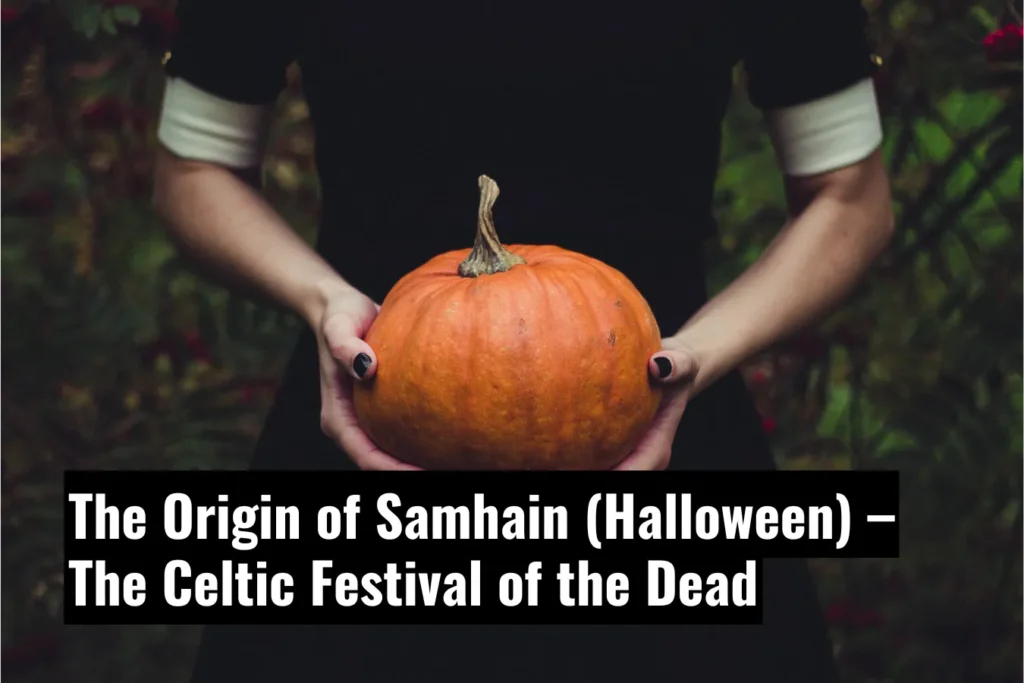

What is the origin of Samhain, Samonios, or Oíche Shamhna? This ancient celebration is undoubtedly one of the most important festivals in Celtic culture—a deeply spiritual society. Samhain is celebrated at the time when the veil between the world of the living and the dead is at its thinnest. It’s a moment of transition, where time stands still, and the spirit world opens its doors to us. The presence of the Sidhe (fairy folk) can be felt in our very bones. Mother Earth begins her long rest during the six months of the dark season, until she awakens again at Beltane. This is how the Coligny Calendar marks the turning of the year.
Samhain also happens to be my birthday—so to honor this powerful date, I’d love to share with you everything it represents. I hope you enjoy it, and I wish you a magical, soul-filled Samhain.
The word Samhain comes from the Gaelic language and means “summer’s end.” Samhain is considered the most important Celtic festival of the pagan European calendar (before the rise of Christianity). It marks the Celtic New Year and the beginning of the dark season.
In the Wheel of the Year, Samhain sits between Mabon (Autumn Equinox) and Yule (Winter Solstice). It’s a time of deep transition, when the boundaries between the two worlds—the living and the dead—fade away, allowing for communication across the veil.

Samhain is known by many names, depending on the Celtic region:
Samonios (Gaulish)
Trinouxtion Samonii (from the Coligny Calendar)
Oíche Shamhna (Modern Irish)
Calan Gaeaf (Welsh)
Samain (Old Irish)
Samhuinn (Scottish Gaelic)
Kala-Goanv (Breton)
Samaín (Galician)
Samhain is traditionally celebrated on the night of October 31st to November 1st in the Northern Hemisphere (or May 1st in the Southern Hemisphere). This coincides with the first frost in the British Isles, the blooming of juniper, and the ripening of pumpkins. However, this date is symbolic—it has been observed for over 3,000 years by Celtic peoples across Europe.
In Scotland, Samhain is often celebrated on November 11th, as rural communities during the 19th century held their festivities on November 12th or 13th.
According to the ancient Coligny Calendar (a lunisolar Celtic calendar from the 2nd century), Samhain was celebrated over three nights—Trinouxtion Samonii—suggesting the festival was considered especially sacred and extended in duration.
Around 2,000 years ago in Celtic Ireland, Samhain marked the division between the light half (summer) and dark half (winter) of the year. During this time, the veil between this world and the Otherworld was at its thinnest, allowing spirits to pass through. Ancestors were honored and invited into homes, while harmful spirits were warded off through rituals.
People wore disguises and masks—often made from animal hides or natural materials—to mimic or scare away evil spirits. This ancient tradition is the origin of our modern Halloween costumes.

During Samhain, people paid tribute to Cernunnos, the antlered god of the wild, nature, and the cycle of life and death. Cernunnos is often associated with the Fianna, a legendary band of Celtic warriors. His antlers represent the cycles of nature: they fall in winter and regrow in late summer, peaking in spring.
In Brittany (France), this seasonal symbolism lives on in the tradition of baking Kornigou—horn-shaped pastries. According to mythology, the Horned God separates from his consort goddess during the light half of the year but returns to her in the dark half, surrendering his antlers in the Otherworld. This echoes tales of Dagda and Morrighan, Celtic deities whose union occurs at Samhain before the great battle against the Fomorians.
Bonfires and feasts played a vital role in Samhain celebrations:
Animal bones were thrown into communal fires—hence the word bonfire (from “bone-fire”).
Household hearths were extinguished and then relit from the sacred communal fire.
Food offerings were prepared for the spirits of ancestors and shared with the less fortunate.
These practices honored the cycles of death and rebirth and ensured protection and blessings for the coming year.
Two hills in Ireland’s Boyne Valley are closely associated with Samhain:
Tlachtga (Hill of Ward): The central location for the great Samhain fire festival.
Tara: A royal ceremonial site aligned with Samhain energies.
The Mound of the Hostages at Tara—a 4,500 to 5,000-year-old passage tomb—is aligned with the sunrise during Samhain. This alignment predates the arrival of the Celts in Ireland, suggesting that the significance of this time of year stretches far back into prehistory.

Samhain features prominently in the Ulster Cycle of Irish mythology:
Echtra Nerai: A warrior named Nera enters the Otherworld on Samhain night.
Cath Maige Tuired: The Dagda and Morrighan unite before a major battle with the Fomorians.
Queen Medb of Connacht: Waits until Samhain to launch a cattle raid on Cooley.
Lugh and Fionn Mac Cumhaill also make their dramatic appearances on this sacred date.
Writers frequently used Samhain to add a layer of magic and spiritual depth to stories, showing its central place in Celtic imagination and seasonal spirituality.
Although little written evidence survives about the Druids (their teachings were oral), it’s believed that Samhain was one of their most important festivals. Celebrations likely occurred from November 1st to 7th, midway between the Autumn Equinox and Winter Solstice.
During Samhain, Druid priests acted as mediums, communicating with ancestors and spirits in sacred rituals. To the Celts, the Otherworld was not a place of punishment or fear, but of perfect happiness—free of hunger and pain. They welcomed the spirits of their ancestors with joy, seeking their guidance for the year to come.

Samhain marked the end of hunting and fighting seasons. Warriors such as the Fianna retired to winter camps until returning at Beltaine.
Fionn MacCumhaill, the legendary warrior, first appeared at the royal court of Tara during Samhain. The god Lugh also made his entrance at this sacred time. When ancient storytellers wanted to create a sense of mystery and magic, they set their tales during Samhain—a night when anything was possible.
You may also be interested in these
Christianity eventually absorbed elements of Samhain into All Saints’ Day (November 1) and All Souls’ Day (November 2).
The use of costumes to scare off spirits survived in the modern tradition of Halloween. Irish immigrants brought these customs to America in the 19th century, especially during the Great Famine. There, Halloween evolved into one of the most beloved holidays.
The carving of pumpkins into Jack-o’-Lanterns also comes from Irish folklore—originally carved from turnips!
Explore the ancient hill of Tlachtga, where Samhain was once celebrated with sacred fire rituals.
Try these Pumpkin recipes perfect for a Samhain feast with your loved ones.
If this article resonated with you, I invite you to follow me on my Pinterest profile, where I share daily inspiration to nourish the soul and uplift the spirit. Don’t miss out on the magic of every new post! Follow me and join me on this journey of connection and transformation.

